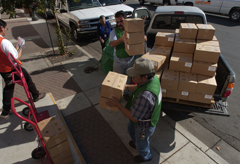
Public health, other agencies join forces to practice emergency
preparedness plans
While San Benito County workers have been working on an
emergency preparedness plan for two years and completed a final
draft in April 2007, they just this week put some of their words
into action with a drill Aug. 29.
Public health, other agencies join forces to practice emergency preparedness plans
While San Benito County workers have been working on an emergency preparedness plan for two years and completed a final draft in April 2007, they just this week put some of their words into action with a drill Aug. 29.
“To have plans in place doesn’t do any good if we don’t try them out,” said Samela Perez, the public information officer for the Public Health Division and the emergency preparedness coordinator for the drill. “Anything could happen.”
County staff worked with Plan A Solutions, Inc., to come up with the exercise, which required the dissemination of more than 4,000 dosages of antiviral drugs throughout San Benito County. The San Benito County Board of Supervisors approved $17,225 for the contract with Plan A.
The point of the drill was to test the ability of county employees to move strategic national stockpile resources – the types of items that would be sent by the state or national government in times of emergency – throughout the county. The SNSs used for the drill included the antivirals, latex gloves and surgical masks.
“We are not testing time, but our ability to distribute,” Perez said.
While responses will be different for a variety of emergencies – from floods to earthquakes – the Thursday morning drill was based on a pandemic influenza outbreak with multiple locations. Health officials throughout the world have been concerned about a possible pandemic influenza outbreak since avian flu (H5N1) started spreading from bird populations to people.
While health officials cannot predict if avian flu will mutate to spread easily between people, they do know that pandemic flus have been a regular occurrence throughout history. Three pandemics spread across the world in the 20th century. The most fatal was the 1918 Spanish flu. As with avian flu, the Spanish flu originated in birds.
The highest fatality rate during the 1918 pandemic were people in their 20s.
With pandemic flu as the faux emergency, the agencies involved in the drill included the Public Health department, Public Works, the Office of Emergency Services and medical professional volunteers. At 9 a.m., 25 county employees and volunteers gathered at Veterans Memorial Hall to repackage supplies and deliver them to Hazel Hawkins Hospital and other skilled living facilities in Hollister. The participants wore colored vests to help identify their role in the drill. Perez wore a blue vest as part of the planning team. Public works employees wore green vests as part of the repackaging and transportation team. Others wore yellow, red and orange.
The atmosphere was calm and the pace was slow, as everyone focused on completing their tasks whether it be sorting boxes of medication and wrapping them together in plastic wrap, tracking inventory as it left the building or taking notes on what others were doing as an observer.
Perez emphasized that though the county’s plan is completed, it is evolving and will change based on what worked and what didn’t work during the current drill.
“It’s a very fluid plan,” she said. “Today’s event is a learning process.”
One reason the planning group focused on a pandemic flu instead of a natural disaster such as an earthquake or flood is that in a situation of pandemic flu outbreak, county employees and residents would largely need to take care of themselves.
“The resources we request in an earthquake would be much different,” Perez said. “With panflu, services would be needed over a geographically-wide area. With an earthquake, we could turn to our neighbors.”
In an earthquake, major damage would be likely centered in a smaller area so emergency services from other counties would be available.
“[With panflu], everyone would be tapping into the same resources,” Perez said.
While the first drill undertaken focused on getting medical supplies to emergency facilities, such as the hospital, the county has discussed plans for getting resources to rural areas or other high-risk populations.
“I believe schools will play a huge role in getting information and resources out,” Perez said. “They might serve as shelters.”
While some things can be planned for, others cannot. The morning of the drill, people called the hospital and other medical facilities to find out how many beds were filled. They repackaged boxes of Tamiflu and Relenza, both types of antivirals, based on the number of people at the hospital, including health professions and visitors.
Nearly 3,500 dosages of Tamiflu were distributed and 1,200 dosages of Relenza, antivirals that can help prevent flu or lessen the symptoms.
“One is oral and one is inhaled,” explained Jeanne Rosati, a pharmacist. “It’s a matter of convenience. Relenza is usually used in older populations, but they do the same job.”
Rosati, a pharmacist at Pennywise Drug Store, heard about the drill from a friend, who works for public health. She volunteered her time for the drill.
While the county is working hard to keep their emergency plans up to date, Perez emphasized they do need medical health professionals to volunteer. They also have plenty of information on how individuals and families can prepare. Even in their drill, the group had cross-trained and planned for back-up participants because in a pandemic flu situation, many people are likely to be out sick.
“The state has stated if there is one case [of pandemic flu,] students will be dismissed from school,” Perez said. “People and businesses need to have plans in place to deal with that.”









